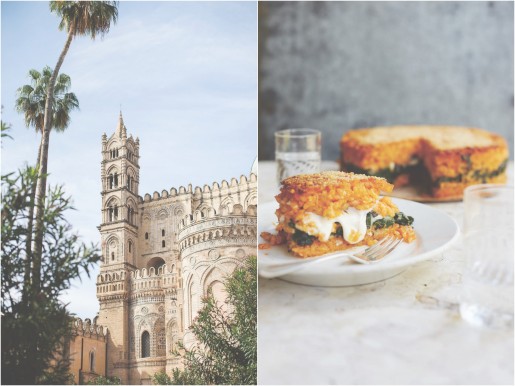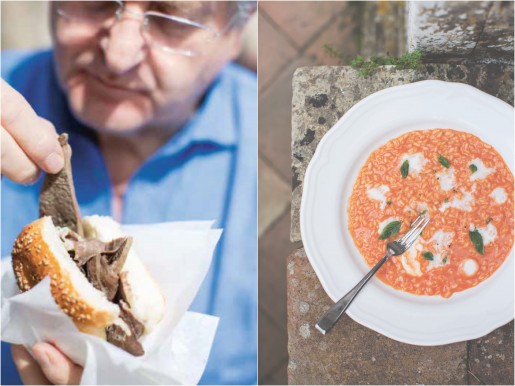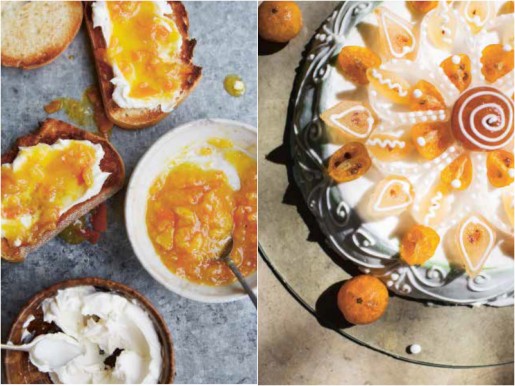Sicily… Italian Fusion Cooking
Our big, bright, shiny new book is out! It’s called Sicily, Recipes from an Italian Island. It follows in the series produced by the brilliant publisher Kate Pollard from Hardie Grant UK. She steered our happy little crew through the regions of Amalfi, Venice, Rome and now Sicily to produce stunning books with Helen Cathcart’s enticing photographs.
It’s been amazing to see the complete contrast in the cooking styles from the North to the South of Italy. Venice was about spice and rice, Amafi was fish on a dish as well as pizza and lemons everywhere, Rome was quick dishes and famous pasta greats such as Carbonara, Cacio e Pepe and Amatriciana – but Sicily, well that’s a whole different thing. I was astounded to read about who had lived in Sicily; practically everyone has invaded this poor, but strategically-placed little island. Most did nothing to improve life for the locals but all left their mark on the food. I think it must be one of the first places that had fusion food. You will have to read the book for our culinary time line of Sicily but here are a few points that I thought fascinating:-

- The Phoneticians were some of the first to arrive and live with the locals in around 650BC. They made themselves rich by picking out shellfish from tiny shells. These shellfish made a rich purple dye called Tyrian that was used to create a rare purple cloth for royalty. Apparently the process smelt awful and it took loads of shellfish to dye one piece of fabric.
- The Greeks built Syracuse and incredible temples which still stand today. They also built the first chef’s school as Syracuse was the gastronomic capital of the world. The first ever cookbook in the West was produced here called The Lost Art of Cooking by Mithaecus.
- The Romans arrived and took over the growing and supply of wheat and called Sicily “the empire’s granary”. Caligula had a holiday home on the island where he would hunt and enjoy game flavoured with spices such as ginger, cinnamon and pepper. At the same time lemon, plum and cherry trees were imported from Asia.
- After the fall of the Roman Empire, Sicily was under Arab rule; Muslim, Christian and Jewish traders crowded the markets of Palermo. The Arabs brought better methods of irrigation and agriculture and most importantly, for the whole of the Italian cuisine of the future, they brought the first pasta to Italy from Palestine called itriyya. Pasta making became a huge business in Sicily and many families became immensely rich by making and selling dried pasta for export.
- For centuries strands of pasta were originally eaten with your hands and dangled above your mouth. Cous-cous, another type of pasta, was introduced by the Arabs and is still cooked on the west coast today.
- The poor ate vegetables or were given the entrails of the animals to eat. This formed the basis of Sicilian street food which is still adored today. This is Giancarlo relishing spleen-in-a-bun. On the right is one of my favourites, a cherry tomato and basil risotto.

- In 1060 the Normans landed. They were descendants of Vikings and it’s not unusual to see red-haired Sicilians today. After a rough start they settled in and Roger II (Ruggero in Italian) became a hero. He embraced the multi-cultural society, he spoke French, Latin, Greek and Arabic, employed Muslim chefs and wafted around his court wearing Arab dress. He built the stunning Palantine Chapel in Palermo which incorporates dazzling craftsmanship from all the various religions of the time.
- After a brief rule by the German Empire, the Spanish arrived in 1302 and brought cocoa, cacti, pumpkins, tomatoes and peppers. In 1492 they threw out the Jews who had to flee to Rome, Venice and elsewhere in the world taking with them culinary traditions learnt from the Arabs such as using pinenuts and raisins in a dish.
- The Englishman John Woodhouse invented and began the production of the sweet fortified wine Marsala in 1773. It is the alcohol used to flavour tiramisu.
- The French, under the rule of King Ferdinand IV and his wife Maria Carolina, sister of Marie Antoinette, brought their chefs to Sicily known as the Monzu from the word Monsieur who influenced the cooking again.
- Finally in 1860 Garibaldi and his redshirts took over and Sicily was united with the mainland to become Italy.
There are loads more fascinating facts about this melting pot of culinary history. Here is one of my favourite recipes from the book that is easy to make and has loads of uses.
Marmellata di Mandarini – Clementine marmalade

We loved this bright orange bittersweet marmalade for breakfast on yoghurt when we were in Sicily. It is equally at home spooned over a ice cream, ricotta or on toast with mascarpone. The perfume of bubbling clementines fills the house as you make it and a jar makes a good gift.
This will be a loose-set marmalade and fairly low in sugar compared to traditional varieties. There isn’t enough sugar to enable the marmalade to be kept safely out of the fridge, but since we’re only making a small batch a few jars don’t take up too much room.
Makes approximately 1.5 kg (3 lb 5 oz)
1 kg (2 lb 3 oz) clementines
juice of 2 lemons
1 litre (34 fl oz/4¼ cups) water
400 g (14 oz/2 cups) granulated sugar
Remove the stalks and hard knobbly bits at the top of the clementines and cut in half, keeping the skin on. Now roughly chop into smaller pieces by hand or in a food processor. The pieces should be no bigger than 1 cm (½ in) cubes. Put them into a large heavy-based saucepan with the lemon juice and water and bring to the boil. Turn the heat down to a simmer and allow the mixture to bubble away slowly for 1 hour. By this time the skins should have softened so that you can squash them easily with a spoon against the side of the pan and the marmalade will have thickened to a soft, runny set.
Next add the sugar and stir through. Bring to a rapid boil for around 5 minutes or until the sugar has dissolved. Pour into clean, warm jars (I do this by rinsing them out with hot water from the kettle) and screw on the lids. Allow the jars to cool and keep in the fridge.
The book is available from Amazon and all good bookshops but you can order copies signed by us for you here.
